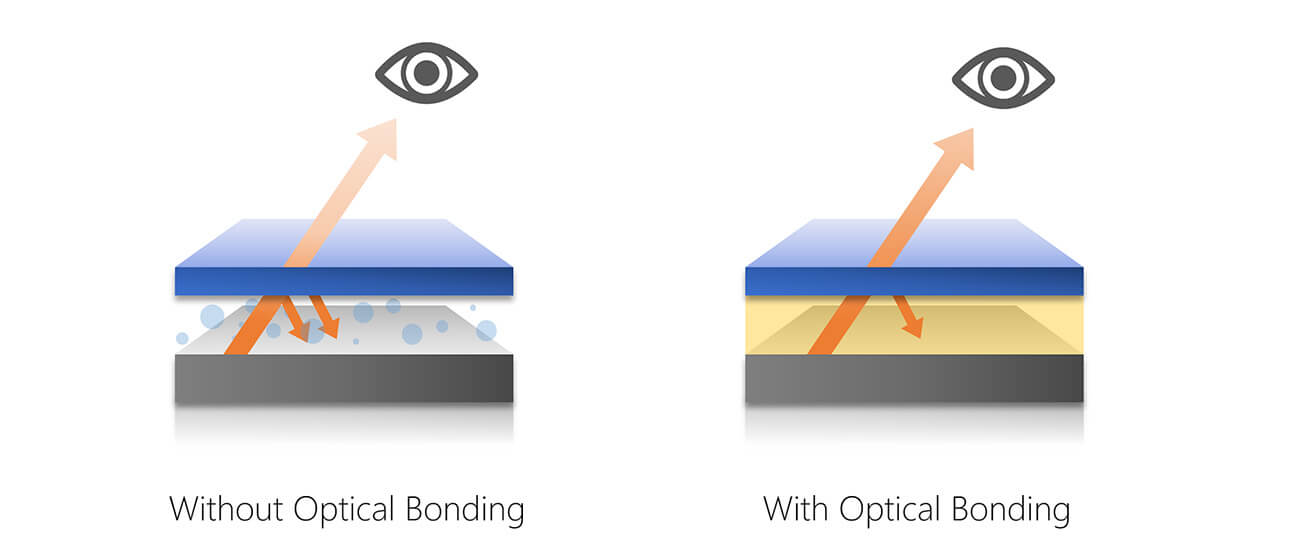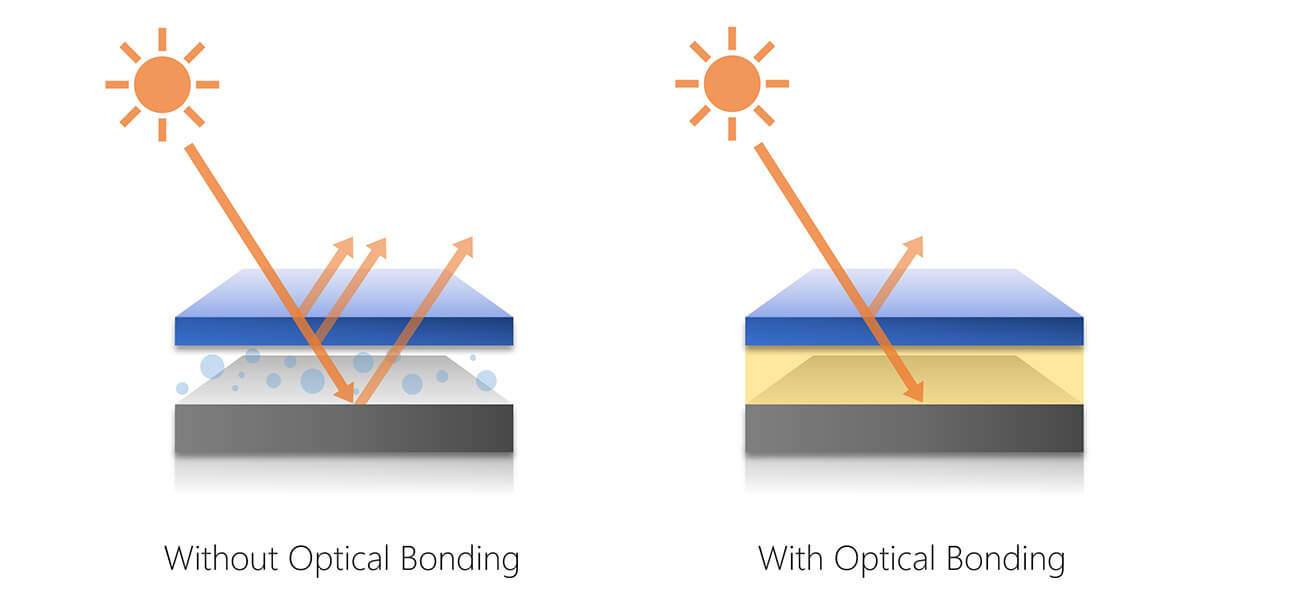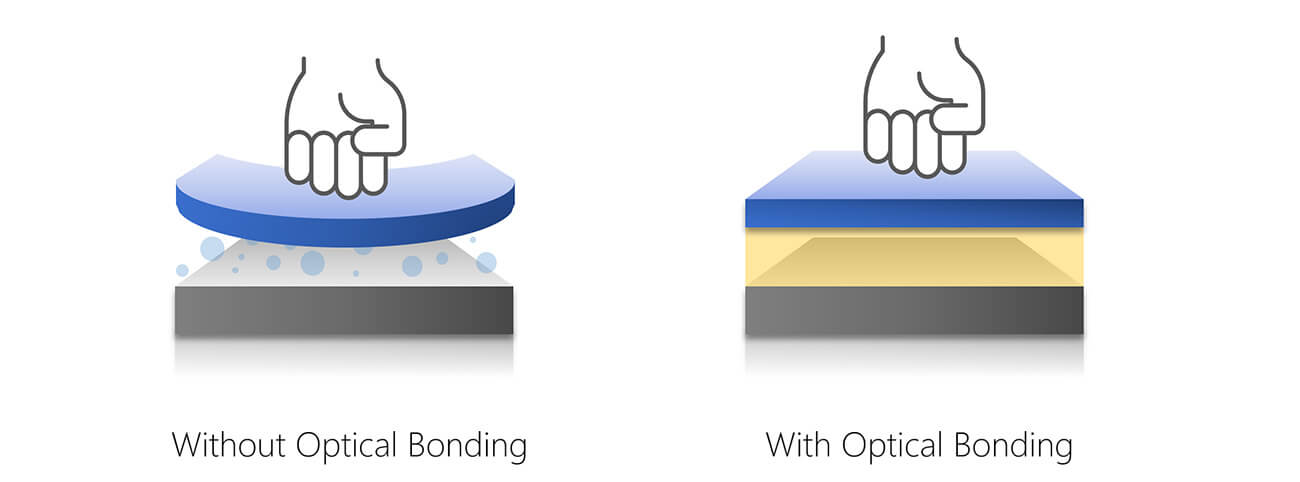
The touchscreen function is increasingly becoming a common display feature in industry. It is an additional feature because specific components need to be attached to the standard display to make the screen interactive. Those elements are a touch sensor, a controller, and a cover glass. You can combine them with display in several ways, but nowadays the most technologically advanced and widely recommended is the optical bonding method.
Table of Contents
What is optical bonding?
Optical bonding serves to bond the display with the touch panel. This process requires carefully selected glue and unique manufacturing technology (usually protected by patents or business confidentiality). This results in high-quality final products with better optical performance, durability, and further benefits described in the article.

Optical bonding process
We mentioned earlier that the detailed optical bonding process is kept confidential by the companies performing it. The general step-by-step of bonding is as follows:
Preparation
The process starts with choosing the appropriate type of glue depending on the required display parameters, such as its size, location of the device (indoors or outdoors), and estimated operating temperatures. At this stage, the display, glass, and touch panel must be thoroughly cleaned.
Adhesive injection
This involves precisely applying glue on the entire screen surface. The specific glue recipes are strictly protected, although there three general types of bonding materials: silicones, epoxy resins, polyurethanes (now becoming obsolete due to yellowing over time).
Bonding and treating
This is the crucial step of the entire process because it’s applying the touch panel to the LCD module. Avoiding any gaps and air bubbles is the most important issue here. Then the glue is treated with UV light, as traditional heat treatment would increase the risk of material shrinkage.
SOCA – alternative optical bonding process
An interesting variation of optical bonding is SOCA, which stands for vacuum bonding of gel adhesive.
What is SOCA bonding?
SOCA (Solid / Silicone Optically Clear Adhesive) involves using a translucent gel that is laminated under high pressure in the form of adhesive sheets. High-quality silicone mixtures are used for this purpose, which then serve as a bonding between the protective glass, the touch panel sensors, and the LCD display.
Optical bonding process with SOCA
The optical bonding process in the SOCA method resembles lamination. It involves laying two-sided gel sheets, tailored to fit the size of display components, which are then vacuum bonded on both sides.
Advantages of SOCA optical bonding
In this technology, UV curing is not necessary, thereby the risk of material yellowing is reduced. Compared to the standard “wet” process describe above, the SOCA method is easier to implement and the adhesive maintains greater flexibility, thereby avoiding the mura effect. Importantly, bonding using SOCA gels is reversible and components can be re-bonded again, which facilitates any repairs and modifications, thus reducing the cost of servicing the device. The SOCA optical bonding technology positively affects the quality of the displayed image.
How optical bonding affects display quality?
Optical bonding has many advantages compared to other methods. We present the most important features below.
Improved Display Quality – Reduced Light Reflections and Enhanced Contrast
The optical bonding method eliminates the air gap between the protective glass, the touch sensor, and the display, significantly improving the quality and readability of the displayed image. It is especially visible in high sunlight environment (e.g., outdoor applications) or strong artificial light (e.g., in illuminated production halls or hospital operating rooms). In those use cases the main problem affecting display readability is the screen brightness and contrast. Contrast is the ratio of the white to black levels. Simply put, the display contrast ratio indicates the difference in light intensity between the brightest white pixel and the darkest black pixel. The main goal of the optical bonding process is to increase the display contrast ratio by reducing the amount of reflected ambient light.

In addition, the optical bonding technology allows the display to be combined with transparent electromagnetic protection layers or special coatings such as AG (anti-glare), AR (anti-reflective), HC (hard coating), and polarizing filters.
Reduced Disadvantages of Air Bonding
A basic alternative to optical bonding is the air bonding, which involves bonding with adhesive put on the edges, just like using a gasket. This means that in air bonding, there is air gap between the layers, and light from an external source refracts, thus reflecting some of the light back and creating screen reflections.
The same effect occurs in reverse – light generated by the backlight of the LCD passes through mediums (in the case of glass and air) with different light refraction indexes, or permeability, causing bending of the light. The result of using air bonding is decreased contrast and readability of the display.

In addition, complications can arise with thick cover glass in displays with touch panels, where the touch function may not work correctly due to lack of proper touch sensitivity (called ghost effect). There might occur several issues during calibration of the touch panel controller and touch sensor if a commercial controller is used for industrial applications.
Condensation Reduction and Dust Protection
Humidity and contaminants can penetrate the gaps between screen layers, negatively affecting display readability. The space filled with optical adhesive eliminates this problem, guaranteeing image clarity in any environment, such as outdoor applications, production halls, warehouses, or hospitals.

Increased Mechanical Durability
Removing the air gap with optical adhesive increases the physical durability of the module, allowing its use in public spaces, industrial plants, and military applications. For example, the optical bonding process meets the rules of the IK7 standard, providing protection against mechanical impacts with the energy of 2J.

Extended Temperature Range and EMI Filtering
The use of optical bonding means additional enhancements, like wider operating temperature range and increased resistance to EMI (Electromagnetic Interference). Extended display performance in extreme low temperature range can be achieved by using ITO (Indium Tin Oxide) heaters on the glass surface. To reduce the electromagnetic interference, EMI filters can additionally be applied using the ITO technology. This effectively reduces undesirable effects from both external and internal sources, which translates into improving the quality of device operation and increasing its reliability.
Optical Bonding – Risks of Incorrect Implementation
Considering the end user experience and the operating environment of the device, we support the process of selecting the right type (or combination) of adhesive material (resin, silicone), to minimize any potential negative effects. In particular, the following aspects should be considered before applying the optical bonding process:
Mura Effect
Distortions resulting from material tensions in the adhesive can lead to mechanical damage to the TFT LCD panel, which would be particularly visible when displaying dark content and in low light. A carefully selected adhesive material and a gradual curing process contribute to reducing tensions, thereby significantly reducing the risk of the mura effect.
Delamination – adhesive shrinkage
Shrinkage of the adhesive, due to incorrect curing at too high temperatures, can cause delamination – when the bonding material would separate from the surface material. To minimize the risk of delamination, it is essential to follow a strict bonding process and use suitable materials – in which we can support our clients. Thermal tests carried out have shown the absence of this phenomenon at 85°C.
Adhesive Yellowing
The yellowing of adhesive material can occur over time due to UV radiation or exposure to high temperatures. This can compromise the visual quality of the display and result in a less accurate color representation. To prevent this issue, we recommend UV-resistant and thermally stable adhesives in the optical bonding process. For this reason, Unisystem offers support in selecting the right adhesive compound, considering the requirements of the end user’s application, to guarantee the highest possible performance and functionality of the display module.
Where is optical bonding best used?
Optical bonding, thanks to its high-quality performance, is gaining popularity in a variety of applications, especially when rigorous environmental conditions such as a wide temperature range or direct sunlight readability are required. The technology is gaining acceptance not only in smartphones or car dashboard displays (like in Tesla cars), but also in advanced industrial applications:
- medical electronic devices,
- military equipment,
- industrial machines and HMIs.
In these sectors, quality, durability, and optical specifications are crucial, which contributes to the ever-increasing interest in optical bonding.
Conclusion
Optical bonding is a key technology in ensuring high-quality, reliable displays for a wide range of applications. By eliminating the air gap between the protective glass, touch sensor, and display, optical bonding greatly improves the display’s readability, contrast, and durability. It also offers additional benefits such as extended temperature range and EMI filtering. However, it is crucial to select the right adhesive materials and follow a strict bonding process to minimize the risks associated with incorrect execution, such as the mura effect, delamination, and adhesive yellowing.
If you require any additional information, please contact us.